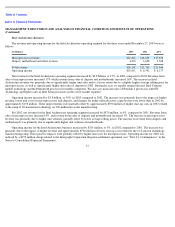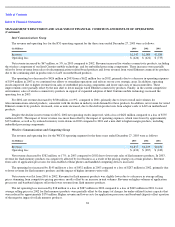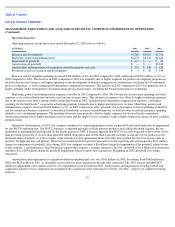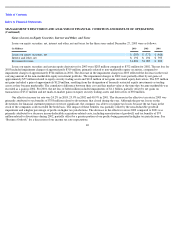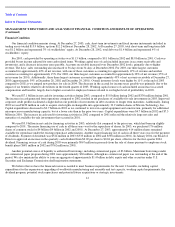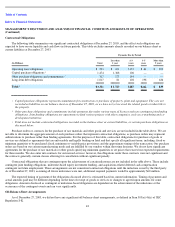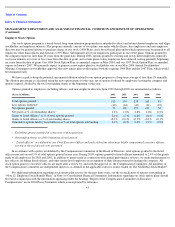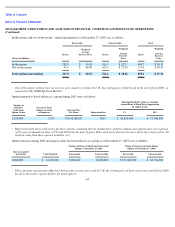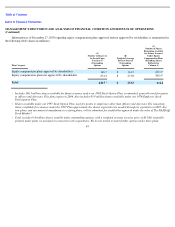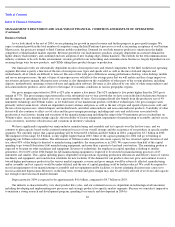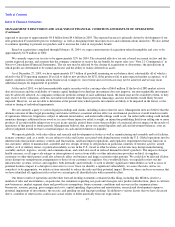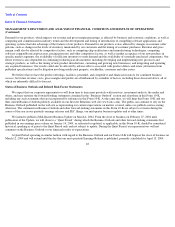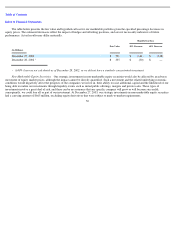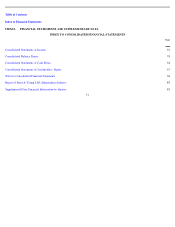Intel 2003 Annual Report Download - page 50
Download and view the complete annual report
Please find page 50 of the 2003 Intel annual report below. You can navigate through the pages in the report by either clicking on the pages listed below, or by using the keyword search tool below to find specific information within the annual report.
Table of Contents
Index to Financial Statements
MANAGEMENT’S DISCUSSION AND ANALYSIS OF FINANCIAL CONDITION AND RESULTS OF OPERATIONS
(Continued)
expected to increase to approximately $4.8 billion from $4.4 billion in 2003. The expected increase is primarily driven by development of our
next-generation 65-nanometer process technology, as well as designing future microprocessors and communications initiatives. We also intend
to continue spending to promote our products and to increase the value of our product brands.
Based on acquisitions completed through February 18, 2004, we expect amortization of acquisition-related intangibles and costs to be
approximately $170 million in 2004.
We currently expect our tax rate to be approximately 32% for 2004. The estimated effective tax rate is based on current tax law and the
current expected income, and assumes that the company continues to receive the tax benefit for export sales (see “Note 21: Contingencies” in
Notes to Consolidated Financial Statements). The tax rate may be affected by the closing of acquisitions or divestitures, the jurisdictions in
which profits are determined to be earned and taxed, and the ability to realize deferred tax assets.
As of December 27, 2003, we have approximately $3.7 billion of goodwill remaining on our balance sheet, substantially all of which is
related to the ICG operating segment. If we fail to deliver new products for ICG, if the products fail to gain expected market acceptance, or if
market conditions in the communications business fail to improve, our revenue and cost forecasts may not be achieved and we may incur
additional charges for impairment of goodwill.
At the end of 2003, we held non-marketable equity securities with a carrying value of $665 million. If the level of IPO market activity
does not increase and the availability of venture capital funding for technology investments does not improve, our non-marketable investments
may be adversely affected. As companies within our portfolio attempt to raise additional funds, the funds may not be available to them, or they
may receive lower valuations, with less favorable investment terms than in previous financings, and our investments would likely become
impaired. However, we are not able to determine at the present time which specific investments are likely to be impaired in the future, or the
extent or timing of individual impairments.
We are currently a party to various legal proceedings and claims, including claims related to taxes. Management does not believe that the
ultimate outcome of these legal proceedings and claims will have a material adverse effect on our financial position or overall trends in results
of operations. However, litigation is subject to inherent uncertainties, and unfavorable rulings could occur. An unfavorable ruling could include
monetary damages, additional taxes owed or, in cases where injunctive relief is sought, an injunction prohibiting Intel from selling one or more
products. If an unfavorable ruling were to occur in any specific period, there exists the possibility of a material adverse impact on the results of
operations of that period or future periods. Management believes that, given our current liquidity and cash and investment balances, even an
adverse judgment would not have a material impact on cash and investments or liquidity.
We operate globally, with sales offices and research and development activities as well as manufacturing and assembly and test facilities,
in many countries, and, as a result, we are subject to risks and factors associated with doing business outside the U.S. Global operations involve
inherent risks that include currency controls and fluctuations, tariff and import regulations, and regulatory requirements that may limit our or
our customers’ ability to manufacture, assemble and test, design, develop or sell products in particular countries. If terrorist activity, armed
conflict, civil or military unrest, or political instability occurs in the U.S., Israel or other locations, such events may disrupt manufacturing,
assembly and test, logistics, security and communications, and could also result in reduced demand for Intel’s products. The impacts of major
health concerns, or of large-scale outages or interruptions of service from utility or other infrastructure providers on Intel, its suppliers,
customers or other third parties could also adversely affect our business and impact customer order patterns. We could also be affected if labor
issues disrupt our transportation arrangements or those of our customers or suppliers. On a worldwide basis, we regularly review our key
infrastructure, systems, services and suppliers, both internally and externally, to seek to identify significant vulnerabilities as well as areas of
potential business impact if a disruptive event were to occur. Once we identify a significant vulnerability, we assess the risks, and as we
consider it to be appropriate, we initiate actions intended to reduce the risks and their potential impact. However, there can be no assurance that
we have identified all significant risks or that we can mitigate all identified risks with reasonable effort.
Our future results of operations and the other forward-looking statements contained in this filing, including this MD&A, involve a
number of risks and uncertainties—
in particular, the statements regarding our goals and strategies, new product introductions, plans to cultivate
new businesses, market segment share and growth rate assumptions, future economic conditions and recovery in the communications
businesses, revenue, pricing, gross margin and costs, capital spending, depreciation and amortization, research and development expenses,
potential impairment of investments, the tax rate, and pending tax and legal proceedings. In addition to various factors that we have discussed
above, a number of other factors could cause actual results to differ materially from our expectations.
47


